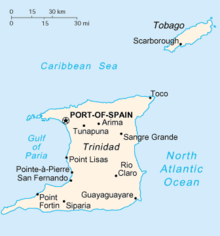Trínídád
Ìrísí
| Sobriquet: Land of the Hummingbird | |
|---|---|
 Map of Trinidad | |
| Jẹ́ọ́gráfì | |
| Ibùdó | Caribbean |
| Àwọn ojú-afọ̀nàhàn | 10°27′38″N 61°14′55″W / 10.46056°N 61.24861°WCoordinates: 10°27′38″N 61°14′55″W / 10.46056°N 61.24861°W |
| Àgbájọ erékùṣù | Lesser Antilles |
| Ààlà | 4,768 km2 (1,840.9 sq mi) |
| Ibí tógajùlọ | 940 m (3,080 ft) |
| Orí ilẹ̀ tógajùlọ̀ | El Cerro del Aripo |
| Orílẹ̀-èdè | |
Trinidad and Tobago | |
| Ìlú tótóbijùlọ | San Fernando (pop. 62,000) |
| Demographics | |
| Ìkún | 1,252,800 |
| Ìsúnmọ́ra ìkún | 262.7 /km2 (680.4 /sq mi) |
| Àwọn ẹ̀yà ènìyàn | [mixed] |

Trinidad (Èdè Sípéènì: "Trinity") is the larger and more populous of the two major islands and numerous landforms which make up the islands of Trinidad and Tobago.[1][2] It is the southernmost island in the Caribbean and lies just 11 km (7 miles) off the northeastern coast of Venezuela. With an area of 4,768 km² (1,864 sq. mi.) it is also the fifth largest in the West Indies. Time zone: GMT -4 (Trinidad does not observe DST).[3]

|
Àyọkà yìí tàbí apá rẹ̀ únfẹ́ àtúnṣe sí. Ẹ le fẹ̀ jù báyìí lọ tàbí kí ẹ ṣàtúnṣe rẹ̀ lọ́nà tí yíò mu kúnrẹ́rẹ́. Ẹ ran Wikipedia lọ́wọ́ láti fẹ̀ẹ́ jù báyìí lọ. |
Itokasi
[àtúnṣe | àtúnṣe àmìọ̀rọ̀]- ↑ "Trinidad and Tobago country profile". BBC News. 2012-10-24. Retrieved 2023-06-16.
- ↑ "People, Culture, Language, Map, Population, & Flag". Encyclopedia Britannica. 1999-07-26. Retrieved 2023-06-16.
- ↑ "Trinidad and Tobago". New World Encyclopedia. 1962-08-31. Retrieved 2023-06-16.


